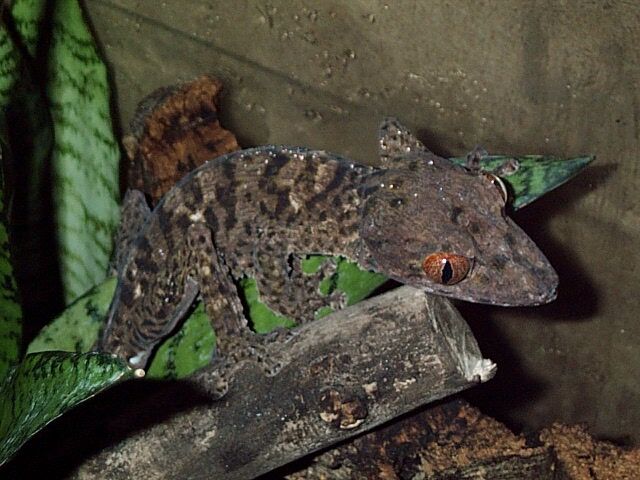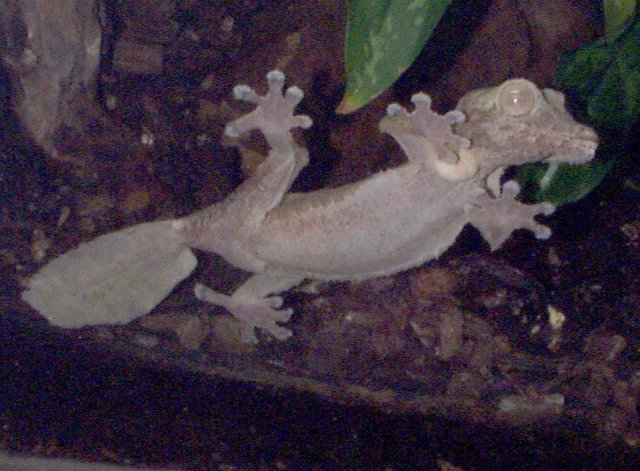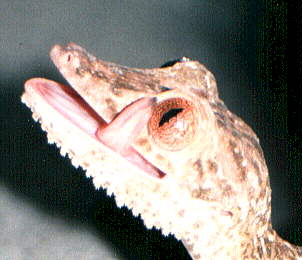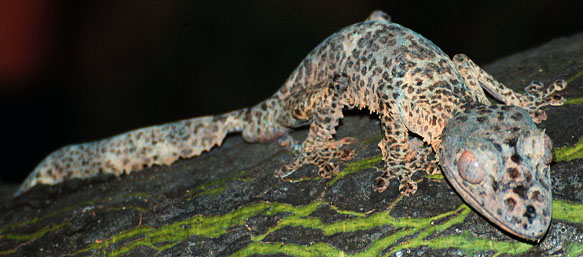(Uroplatus henkeli)

Picture of Gecko courtesy of: Amy Brotcke |
Name: Henkel's Leaf-tailed
Gecko
|
|
Scientific name:
Uroplatus
henkeli
|
|
|
Range: Northern Madagascar
|
|
|
Habitat: Humid rain
forest
|
|
|
Status: Not threatened
|
|
|
Diet in the wild:
Vitamins, crickets, and wax worms
|
|
|
Diet in the zoo:
Large invertebrates
|
|
|
Location in the zoo:
Herpetarium
|
|
The Henkel's Leaf-tailed Gecko is one of
the most unique Geckos in the entire genus. The geneus contains 9 species:
U.
henkeli, U. malahelo, U. lineatus, U. sikorae, U. fimbriatus, U. alluaudi,
U. guentheri, U. ebenaui, U. phantasticus. The species of Uroplatus
are not endangered, but due to the cutting down of the rain forest many
of the species are found in undisturbed parts of Madagascar. Herpetoculturists
are setting up colonies to maintain the species of Uroplatus.U.
henkeli is one of the species that are most frequently kept by breeders;
also U. henkeli is frequently imported from Madagascar.This
method of importing the Uroplatus is very unhealthy and causes stress to
the reptile. CITES is not currently protecting the genus, but at
the current rate of deforestation the genus will soon be threatened.
Avoiding Danger: U. henkeli will hide under plants
or rocks for protection from its predators. This gives the gecko
a camouflage effect making it hard for the predators to detect it.
Also, when the U. henkeli is attacked, it lets out a screeching
distress call that startles the predator, which sometimes results in the
gecko's escape.
|
|
Comments about
the geckos of the Fort Worth Zoo:

Henkel's Gecko at the Fort Worth Zoo
The geckos like to hide in things such as hollow trees, cork bark, and behind plants. The female gecko has two eggs that are buried in the floor, and it takes about 90 days to hatch. The gecko is a nocturnal reptile that can distinguish between light and dark. Since the gecko is a nocturnal animal, the gecko is fed primarily during the evening hours. The snout of the gecko is very fragile, so the animal is fed with tongs or a small cup with a thin sponge layer inside for protection. |
|
Personal Observations:
During the day the gecko spends most of their time sleeping on branches
and cork bark. The larger sized gecko can survive in chamber no smaller
than 2 x 4 x 3 ft/ 60 x 120 x 90 cm. On the other hand the smaller
gecko can survive in a chamber that is 2 x 3 x 2 ft / 60 x 90 x 60 cm.
The environment should include cork bark chips, peat moss, leaves, branches,
and UVB lighting.
|
|
Source Materials and Related Links:
Web sites:
Articles online:
Other sources and personal conversations:
|
|
Send E-mail to r_botello@hotmail.com or to mac@whozoo.org |
WhoZoo Home


